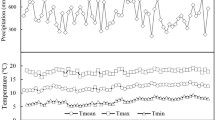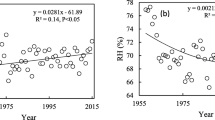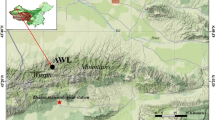Abstract
Purpose
It has been well reported in many studies globally that the increased atmospheric carbon dioxide (CO2) concentration has positively influenced plant growth in the past century. However, it is crucial to understand how long the tree growth trend will remain alongside the rising CO2 concentration before it is tipped over.
Methods
In this study, we focused on studying the long-term tree growth responses to the rising CO2 concentration, in combination with other environmental factors, and its feedback to the changing climate. This study has reported two tree species, Pseudolarix amabilis (P. amabilis) and Cryptomeria japonica (C. japonica), sampled from a subtropical monsoon forest located in eastern China, and established the long-term tree ring chronologies by applying tree ring width measurement and cross dating, and then, basal area increment (BAI) was calculated. Meanwhile, intrinsic water-use efficiency (iWUE) was calculated through the measurement of carbon isotope composition (δ13C) in tree ring samples, and its relationships with BAI and atmospheric CO2 concentration were also quantified.
Results
BAI values continuously increased in both P. amabilis and C. japonica with the rising of CO2 concentration until the atmospheric CO2 concentration tipping points were reached, after which tree growth started to decline with the rising CO2, while iWUE exerted a continuous increase trend with the increasing CO2 concentration.
Conclusions
Tree growth of both species was more photosynthesis driven before reaching the maximum BAI points, once the tipping points of atmospheric CO2 were passed, leading to the positive feed of forest carbon cycling to climate change and global warming. Therefore, tree growth was more water limitation driven in the last 20 years.








Similar content being viewed by others
References
Aasamaa K, Sõber A, Rahi M (2001) Leaf anatomical characteristics associated with shoot hydraulic conductance, stomatal conductance and stomatal sensitivity to changes of leaf water status in temperate deciduous trees. Funct Plant Biol 28:765–774
Andreu-Hayles L, Planells O, GutiÉrrez E, Muntan E, Helle G, Anchukaitis KJ, Schleser GH (2011) Long tree-ring chronologies reveal 20th century increases in water-use efficiency but no enhancement of tree growth at five Iberian pine forests. Glob Chang Biol 17:2095–2112
Barber VA, Juday GP, Finney BP (2000) Reduced growth of Alaskan white spruce in the twentieth century from temperature-induced drought stress. Nature 405:668–673
Barden J (1977) Apple tree growth, net photosynthesis, dark respiration, and specific leaf weight as affected by continuous and intermittent shade. J Am Soc Hortic Sci 102
Bazzaz FA (1990) The response of natural ecosystems to the rising global CO2 levels. Annu Rev Ecol Evol Syst 21:167–196
Beerling D, Woodward F (1996) Stomatal density responses to global environmental change. In: Advances in bioclimatology_4. Springer, pp 171-221
Bert D, Leavitt SW, Dupouey J-L (1997) Variations of wood δ13C and water-use efficiency of Abies alba during the last century. Ecology 78:1588–1596
Brienen RJ, Wanek W, Hietz P (2011) Stable carbon isotopes in tree rings indicate improved water use efficiency and drought responses of a tropical dry forest tree species. Trees 25:103–113
Carrer M, Urbinati C (2004) Age-dependent tree-ring growth responses to climate in Larix decidua and Pinus cembra. Ecology 85:730–740
Climent J, Chambel M, Pérez E, Gil L, Pardos J (2002) Relationship between heartwood radius and early radial growth, tree age, and climate in Pinus canariensis. Can J For Res 32:103–111
de Boer HJ, Lammertsma EI, Wagner-Cremer F, Dilcher DL, Wassen MJ, Dekker SC (2011) Climate forcing due to optimization of maximal leaf conductance in subtropical vegetation under rising CO2. Proc Natl Acad Sci 108:4041–4046
Duchesne L, Ouimet R, Morneau C (2003) Assessment of sugar maple health based on basal area growth pattern. Can J For Res 33:2074–2080
Duquesnay A, Breda N, Stievenard M, Dupouey J (1998) Changes of tree-ring δ13C and water-use efficiency of beech (Fagus sylvatica L.) in north-eastern France during the past century. Plant Cell Environ 21:565–572
Edwards T, Graf W, Trimborn P, Stichler W, Lipp J, Payer H (2000) δ13C response surface resolves humidity and temperature signals in trees. Geochim Cosmochim Acta 64:161–167
Ehleringer JR (1991) 13C/12C fractionation and its utility in terrestrial plant studies. In: Carbon isotope techniques, vol 1. p 187
Enquist BJ, Leffler AJ (2001) Long-term tree ring chronologies from sympatric tropical dry-forest trees: individualistic responses to climatic variation. J Trop Ecol 17:41–60
Fallahi E, Colt WM, Fallahi B, Chun I-J (2002) The importance of apple rootstocks on tree growth, yield, fruit quality, leaf nutrition, and photosynthesis with an emphasis on ‘Fuji’. Horttechnology 12:38–44
Farquhar GD, O’Leary MH, Berry JA (1982) On the relationship between carbon isotope discrimination and the intercellular carbon dioxide concentration in leaves. Funct Plant Biol 9:121–137
Farquhar GD, Ehleringer JR, Hubick KT (1989) Carbon isotope discrimination and photosynthesis. Annu Rev Plant Biol 40:503–537
Fekete I, Lajtha K, Kotroczó Z, Várbíró G, Varga C, Tóth JA, Demeter I, Veperdi G, Berki I (2017) Long-term effects of climate change on carbon storage and tree species composition in a dry deciduous forest. Glob Chang Biol 23:3154–3168
Feng X (1998) Long-term Ci/Ca response of trees in western North America to atmospheric CO2 concentration derived from carbon isotope chronologies. Oecologia 117:19–25
Feng X (1999) Trends in intrinsic water-use efficiency of natural trees for the past 100–200 years: a response to atmospheric CO2 concentration. Geochim Cosmochim Acta 63:1891–1903
Fritts H (2012) Tree rings and climate. Elsevier,
Gagen M, McCarroll D, Edouard J-L (2006) Combining ring width, density and stable carbon isotope proxies to enhance the climate signal in tree-rings: an example from the southern French Alps. Clim Chang 78:363–379
Gagen M, McCarroll D, Loader NJ, Robertson I (2011a) Stable isotopes in dendroclimatology: moving beyond ‘potential’. In: Dendroclimatology. Springer, pp. 147–172
Gagen M, McCarroll D, Robertson I, Loader NJ, Jalkanen R (2008) Do tree ring δ13C series from Pinus sylvestris in northern Fennoscandia contain long-term non-climatic trends? Chem Geol 252:42–51
Gagen M et al (2011b) Evidence of changing intrinsic water-use efficiency under rising atmospheric CO2 concentrations in Boreal Fennoscandia from subfossil leaves and tree ring δ13C ratios. Glob Chang Biol 17:1064–1072
Gedalof Z, Berg AA (2010) Tree ring evidence for limited direct CO2 fertilization of forests over the 20th century. Global Biogeochem Cycles 24
Gómez-Guerrero A, Silva LCR, Barrera-Reyes M, Kishchuk B, Velázquez-Martínez A, Martínez-Trinidad T, Plascencia-Escalante FO, Horwath WR (2013) Growth decline and divergent tree ring isotopic composition (δ13C and δ18O) contradict predictions of CO2 stimulation in high altitudinal forests. Glob Chang Biol 19:1748–1758
Gunderson CA, Wullschleger SD (1994) Photosynthetic acclimation in trees to rising atmospheric CO2: a broader perspective. Photosynth Res 39:369–388
Hanson PJ, Todd DE Jr, Amthor JS (2001) A six-year study of sapling and large-tree growth and mortality responses to natural and induced variability in precipitation and throughfall. Tree Physiol 21:345–358
Hietz P, Wanek W, Dünisch O (2005) Long-term trends in cellulose d13C and water-use efficiency of tropical Cedrela and Swietenia from Brazil. Tree Physiol 25:745–752
Holmes RL (1983) Computer-assisted quality control in tree-ring dating and measurement. Tree-Ring Bull 51–67
Idso S, Kimball B, Anderson M, Mauney J (1987) Effects of atmospheric CO2 enrichment on plant growth: the interactive role of air temperature. Agric Ecosyst Environ 20:1–10
Jump AS, Hunt JM, Penuelas J (2006) Rapid climate change-related growth decline at the southern range edge of Fagus sylvatica. Glob Chang Biol 12:2163–2174
Jump AS, Hunt JM, Penuelas J (2007) Climate relationships of growth and establishment across the altitudinal range of Fagus sylvatica in the Montseny Mountains, Northeast Spain. Ecoscience 14:507–518
Keeling CD et al. (1989) A three-dimensional model of atmospheric CO2 transport based on observed winds: 1. Analysis of observational data. In: Aspects of climate variability in the Pacific and the Western Americas. pp 165–236
Leavitt SW (2010) Tree-ring C–H–O isotope variability and sampling. Sci Total Environ 408:5244–5253
LeBlanc DC (1990) Red spruce decline on Whiteface Mountain, New York. I. Relationships with elevation, tree age, and competition. Can J For Res 20:1408–1414
Luo Y, Sims DA, Thomas RB, Tissue DT, Ball JT (1996) Sensitivity of leaf photosynthesis to CO2 concentration is an invariant function for C3 plants: a test with experimental data and global applications. Glob Biogeochem Cycles 10:209–222
Magnani F, Mencuccini M, Borghetti M, Berbigier P, Berninger F, Delzon S, Grelle A, Hari P, Jarvis PG, Kolari P, Kowalski AS, Lankreijer H, Law BE, Lindroth A, Loustau D, Manca G, Moncrieff JB, Rayment M, Tedeschi V, Valentini R, Grace J (2007) The human footprint in the carbon cycle of temperate and boreal forests. Nature 447:849–851
Marks D, Kimball J, Tingey D, Link T (1998) The sensitivity of snowmelt processes to climate conditions and forest cover during rain-on-snow: a case study of the 1996 Pacific Northwest flood. Hydrol Process 12:1569–1587
McCarroll D, Pawellek F (2001) Stable carbon isotope ratios of Pinus sylvestris from northern Finland and the potential for extracting a climate signal from long Fennoscandian chronologies. Holocene 11:517–526
McCarroll D, Loader NJ (2004) Stable isotopes in tree rings. Quat Sci Rev 23:771–801
McCarroll D, Jalkanen R, Hicks S, Tuovinen M, Gagen M, Pawellek F, Eckstein D, Schmitt U, Autio J, Heikkinen O (2003) Multiproxy dendroclimatology: a pilot study in northern Finland. Holocene 13:829–838
McCarroll D, Gagen MH, Loader NJ, Robertson I, Anchukaitis KJ, Los S, Young GHF, Jalkanen R, Kirchhefer A, Waterhouse JS (2009) Correction of tree ring stable carbon isotope chronologies for changes in the carbon dioxide content of the atmosphere. Geochim Cosmochim Acta 73:1539–1547
Monserud RA, Marshall JD (2001) Time-series analysis of δ13C from tree rings. I. Time trends and autocorrelation. Tree Physiol 21:1087–1102
Nock CA, Baker PJ, Wanek W, Leis A, Grabner M, Bunyavejchewin S, Hietz P (2011) Long-term increases in intrinsic water-use efficiency do not lead to increased stem growth in a tropical monsoon forest in western Thailand. Glob Chang Biol 17:1049–1063
Norby RJ, Todd DE, Fults J, Johnson DW (2001) Allometric determination of tree growth in a CO2-enriched sweetgum stand. New Phytol 150:477–487
Nowak RS, Ellsworth DS, Smith SD (2004) Functional responses of plants to elevated atmospheric CO2–do photosynthetic and productivity data from FACE experiments support early predictions? New Phytol 162:253–280
Penuelas J, Hunt JM, Ogaya R, Jump AS (2008) Twentieth century changes of tree-ring δ13C at the southern range-edge of Fagus sylvatica: increasing water-use efficiency does not avoid the growth decline induced by warming at low altitudes. Glob Chang Biol 14:1076–1088
Peñuelas J, Canadell JG, Ogaya R (2011) Increased water-use efficiency during the 20th century did not translate into enhanced tree growth. Glob Ecol Biogeogr 20:597–608
Polley HW, Johnson HB, Marinoj BD, Mayeux HS (1993) Increase in C3 plant water-use efficiency and biomass over glacial to present CO2 concentrations. Nature 361:7
Raschke K (1970) Temperature dependencies and apparent activation energies of stomatal opening and closing. Planta Med 95:1–17
Regehr D, Bazzaz F, Boggess W (1975) Photosynthesis, transpiration and leaf conductance of Populus deltoides in relation to flooding and drought. Photosynthetica
Reich PB, Walters M, Tjoelker M, Vanderklein D, Buschena C (1998) Photosynthesis and respiration rates depend on leaf and root morphology and nitrogen concentration in nine boreal tree species differing in relative growth rate. Funct Ecol 12:395–405
Sarris D, Christodoulakis D, Koerner C (2007) Recent decline in precipitation and tree growth in the eastern Mediterranean. Glob Chang Biol 13:1187–1200
Saxe H, Ellsworth DS, Heath J (1998) Tree and forest functioning in an enriched CO2 atmosphere. New Phytol 139:395–436
Shao X, Huang L, Liu H, Liang E, Fang X, Wang L (2005) Reconstruction of precipitation variation from tree rings in recent 1000 years in Delingha, Qinghai. Sci China Earth Sci 48:939
Silva LC, Anand M (2013) Probing for the influence of atmospheric CO2 and climate change on forest ecosystems across biomes. Glob Ecol Biogeogr 22:83–92
Silva LC, Anand M, Leithead MD (2010) Recent widespread tree growth decline despite increasing atmospheric CO2. PLoS One 5:e11543
Solomon S, Plattner G-K, Knutti R, Friedlingstein P (2009) Irreversible climate change due to carbon dioxide emissions. Proc Natl Acad Sci:pnas 0812721106
Stokes M, Smiley T (1968) Introduction to tree-ring dating. University of Chicago. Chicago Press, IL, Reprinted 1996. University of Arizona Press, Tucson
Waterhouse JS, Switsur VR, Barker AC, Carter A, Hemming DL, Loader NJ, Robertson I (2004) Northern European trees show a progressively diminishing response to increasing atmospheric carbon dioxide concentrations. Quat Sci Rev 23:803–810
Weiner J, Thomas SC (2001) The nature of tree growth and the “age-related decline in forest productivity”. Oikos 94:374–376
Woodward F, Kelly C (1995) The influence of CO2 concentration on stomatal density. New Phytol 131:311–327
Wullschleger S, Tschaplinski T, Norby R (2002) Plant water relations at elevated CO2 - implications for water-limited environments. Plant Cell Environ 25:319–331
Xu Y, Li W, Shao X, Xu Z, Nugroho P (2014) Long-term trends in intrinsic water-use efficiency and growth of subtropical Pinus tabulaeformis Carr. and Pinus taiwanensis Hayata in central China. J Soils Sediments 14:917–927
Xu Z, Chen C, He J, Liu J (2009) Trends and challenges in soil research 2009: linking global climate change to local long-term forest productivity. J Soils Sediments 9:83–88. https://doi.org/10.1007/s11368-009-0060-6
Yoder B, Ryan M, Waring R, Schoettle A, Kaufmann M (1994) Evidence of reduced photosynthetic rates in old trees. For Sci 40:513–527
Zweifel R, Steppe K, Sterck FJ (2007) Stomatal regulation by microclimate and tree water relations: interpreting ecophysiological field data with a hydraulic plant model. J Exp Bot 58:2113–2131
Acknowledgements
Thanks go to Ningbo Urban Environment Observation and Research Station - NUEORS, Chinese Academy of Sciences, for providing climate data to this research. Appreciations go to Dr. Matthew Brookhouse and Professor Graham Farquhar of The Australian National University for providing me suggestions on this paper and also to Dr. Li Fu for giving me experimental support. T.J.L. received Griffith University Postgraduate Research Scholarship for her Ph.D. study at Griffith University.
Author information
Authors and Affiliations
Corresponding authors
Additional information
Responsible editor: Hailong Wang
Publisher’s note
Springer Nature remains neutral with regard to jurisdictional claims in published maps and institutional affiliations.
Rights and permissions
About this article
Cite this article
Liu, T., Xu, Y., Xu, Z. et al. Effects of climate change and local environmental factors on long-term tree water-use efficiency and growth of Pseudolarix amabilis and Cryptomeria japonica in subtropical China. J Soils Sediments 21, 869–880 (2021). https://doi.org/10.1007/s11368-020-02829-3
Received:
Accepted:
Published:
Issue Date:
DOI: https://doi.org/10.1007/s11368-020-02829-3




